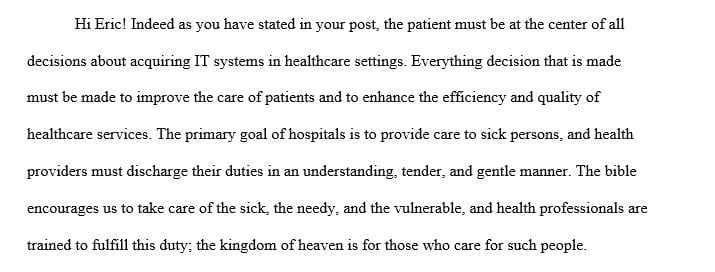The decision to upgrade an existing health information technology (IT) system, or procure a new system is a multidisciplinary process
Discussion Board Forum 2
Eric Samuel
School of Business, Liberty University
Stakeholders in Health IT Systems
The decision to upgrade an existing health information technology (IT) system, or procure a new system is a multidisciplinary process that takes into account the needs, goals, mission and strategic plans of an organization and its stakeholders. This process starts with an assessment of the current organizational needs and system status, and ends with the selection of a product and integration within the organization. The final IT product is often a compromise of the needs and wants from multiple different stakeholders, including but not limited to; the organization, regulatory groups, the IT department, staff, and patients and family members. The unique goals and interests of these groups will be discussed individually.
The Organization
The organization is responsible for verbalizing its goals, mission, and strategic plan. These goals often take into account multiple factors such as financial considerations, public image and potential for growth. The cost of upgrading or procuring new IT systems can be quite high, with a 2011 study reporting costs of $35,000 per provider for equipment and software (Menachemi & Collum, 2011). It is therefore imperative that the organization judge if these financial risks are worth the potential benefit. IT upgrades can be appealing to organizations since sophisticated IT systems are shown to increase hospital revenue through efficient and timely coding, and decrease billing errors and overall costs (Menachemi & Collum, 2011). The need for further growth is also a driving factor when considering an IT upgrade. To maximize return on financial investment and the time spent training staff, it is important to consider a system that allows for future upgrades and modernization throughout its lifecycle.
Regulatory Groups
Regulatory groups are primarily concerned with monitoring at an organizational level to ensure compliance with all applicable federal and state regulations, such as the American Recovery and Reinvestment Act (ARRA) and Patient Protection and Affordable Care Act (PPACA) (Nelson & Staggers, 2018). These acts aimed to control rising healthcare costs, promote innovations in health technology and electronic health records and provide monetary assistance to organizations achieve these goals (Burke, 2010). Additionally regulatory groups monitor organizational compliance with Health Insurance Portability and Accountability Act (HIPAA) provisions pertaining to the physical, technical and administrative privacy of patient information and heath records (Braunstein, 2013).
The IT Department
The IT department functions on an organizational level to provide maintenance and support to the system. When applicable, the need for local tech support must be evaluated to prevent delays in care and ensure productivity for organizations that provide 24 hour services. Occasionally, the system may require downtime for maintenance or unplanned system outages. In these cases, the IT department should have paper redundancy forms for all critical functions of the IT system to prevent delays in patient care. Additionally, the IT department is responsible for continual software and hardware upgrades as technology advances, and the replacement of components when necessary. These functions are crucial to enabling the staff group to perform patient care and make efficient use of the system.
Staff
The term staff refers to any employee that uses the healthcare IT system for patient care. This includes licensed professionals, such as physicians, pharmacists, paramedics, respiratory therapists, nurses or dieticians. Also included are unlicensed professionals, such as coders, billing and insurance staffers and nursing aides. Generally speaking, each group has the same core requirements from the IT system, these include the need for reliability, simplicity of order entry and patient management, and compatibility with current organization practice and processes. Specialized staff such as pharmacy, obstetrics, oncology, emergency care and surgical services often require customized subsystems, such as flowsheets and decision support tools to accomplish their mission (Nelson & Staggers, 2018). Additionally, access to online tools such as Clinical Practice Guidelines and websites that provide evidence based practice information can be accessed through the system to improve access to clinical information.
Patients and Family Members
The patient is arguably the most important group to consider when planning a healthcare system change. Patient considerations for a new healthcare IT system include; ease of appointment booking, quality of care received from the organization, access to longitudinal health data, secured messaging to providers and how patients will access their records digitally. Colossians 3:23-24 reminds us, that work performed for others is a service to the Lord. This strengthens the spirit of patient centered care in the healthcare organization, and reminds us of our individual reasons for entering the healthcare profession.
References
Braunstein, L. M. (2013). Contemporary Health Informatics. Chicago, IL: American Health Information Management Association.
Burke, T. (2010). The Health Information Technology Provisions in The American Recovery and Reinvestment Act of 2009: Implications for Public Health Policy and Practice. Public Health Reports, 125, 141-145.
https://www.ncbi.nlm.nih.gov/pmc/articles/PMC2789830/pdf/phr125000141a.pdf
New International Version Bible. (2014). Bible Online. Https://biblehub.com
Menachemi, N., & Collum. T.H. (2011). Benefits and Drawbacks of Electronic Health Record Systems. Risk Management and Heathcare Policy, 4, 47-55.
https://www.ncbi.nlm.nih.gov/pmc/articles/PMC3270933/pdf/rmhp-4-047.pdf
Nelson, R., & Staggers, N. (2018). Health Informatics: An Interprofessional Approach (2nd Edition) St. Louis, MO: Elsevier.
Answer preview to the decision to upgrade an existing health information technology (IT) system, or procure a new system is a multidisciplinary process
APA
588 words


